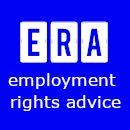The Employment Rights Advice Blog
 Articles, news and updates on employment law in Ireland
Articles, news and updates on employment law in Ireland
for employees and employers
____________________________________________________________________________________________________________________________________________________________________________________________________________________________________________________________________________________________________________________________________________________________________________________________________________________________________________________________
Are you ready for an inspection?
The Workplace Relations Act 2015 effectively transferred the powers of inspection from the National Employment Rights Authority (NERA) to The Workplace Relations Commission (WRC).
It created the WRC which is a one point of contact Government Agency dealing with the various aspects of employment law in Ireland including enforcement.
The WRC has recently issued a “ Guide on Inspections” for employers.
As per the WRC's own figures, they have carried out 2465 inspections, up to March 2016. Following from these inspections 1086 employers were found to be in breach of employment legislation.
An inspector calls
The inspector may be calling in response to a number of reasons.
-
A complaint received alleging non compliance with employment rights legislation
-
A current campaign focused on a particular industry or group or piece of legislation
-
Routine inspection
Usually the inspector will give advance notice of the inspection and request the employer to have the necessary documents available.
The inspection
The inspector identifies themselves and show their Warrant of Appointment to the employer or their representative. They will explain the nature of the visit and the legislation under which they are acting.
The relevant records will be requested and examined in detail. A sample of employees will then be interviewed. A further meeting usually takes place with th employer or their representative to let them know about any preliminary findings.
What if there is minor non-compliance ?
Where there have been minor or accidental breaches the employer is usually afforded an opportunity to rectify them. When proof of rectification has been furnished to the satisfaction of the inspector, the file is closed.
Any errors regarding underpayment of wages must be dealt with as soon as possible.
What about serious breaches?
Serious breaches can be dealt with by fixed payment notices or prosecution through the courts.
The level of cooperation and rectification are serious factors affecting the decision to prosecute through the courts.
What should I do to ensure that I would pass an inspection?
Contact us today and we will carry out an audit of your employment law compliance procedures. That way if anything is in breach it can be fixed before penalties and publicity kick in. If you received notice of a pending inspection and are seeking assistance in preparing for the visit of the inspector, please contact us immediately using the orange Tell Me More button below. Let us know the date of the inspection and we will contact you to help.
Download The WRC Guide to inspections here ;
See also NERA inspections here
Spread the knowledge. If you found this article useful, please like and share using any of the social buttons below.
Image courtesy theilr 
Developing a workplace bereavement policy
“I intend to live forever, or die trying.”
Groucho Marx
 Bereavement leave occurss when an employee takes time off from work following the death of a family member. There is no statutory obligation on an employer to provide bereavement leave. It is considered good practice to allow an employee some paid time off following the death of a close family member. In this article we provide a useful bereavement policy template, and, take an in depth look at how to support a grieving worker in a time of stress.
Bereavement leave occurss when an employee takes time off from work following the death of a family member. There is no statutory obligation on an employer to provide bereavement leave. It is considered good practice to allow an employee some paid time off following the death of a close family member. In this article we provide a useful bereavement policy template, and, take an in depth look at how to support a grieving worker in a time of stress.
Coping with grief
Death is present in life. The death of a loved one affects the bereaved in many ways and for a longer period than many realise. How we cope with the loss of a loved one can affect how we deal with life's challenges, including returning to full output at work.
Employers and work colleagues can help a grieving worker go through the stages of grieving and learn to cope with the loss. This in turn leads to improved morale, reduces the likelihood of sick leave and staff turnover.
Being proactive
Don't wait for a bereavement to occur. Start developing a company bereavement policy now.
This will send out a clear message that you care about your workforce. It will help managers and line staff deal with a difficult subject, knowing that they are following a well thought out policy.
What are the main elements of a bereavement policy ?
This is covered in an excellent publication by the Irish Hospice Foundation entitled Grief at Work. The download link for brochure is at the end of this article.
The main elements are listed as:
1. Leave entitlement
2. The return to work
3. Supporting employees who are grieving
4. Health and Safety
5. Organisational values and ethos
6. Concluding remarks
How much bereavement leave should I provide?
Bereavement or compassionate leave is usually discretionary. There is no statutory entitlement to bereavement leave. It is best practice, however, to grant such leave.
In deciding the amount of bereavement leave to allow, you should take into account what is considered to be custom and practice in the company. If the employer has granted a set amount of days leave in the past then that amount should be mentioned in the company's bereavement policy.
Where custom and practice does not apply, it is usual to grant up to three days paid leave for the death of a close family member. It is important to define a close family member. It usually includes a spouse or civil partner, daughter, son,parent, sister, brother.
Cooperation and communication
Draw up a draft policy. Use it as a basis for discussion with and feedback from all employees. If changes are suggested which are beneficial, then make the necessary adjustments to the policy. Introduce the policy and build in reviews and updates.
Communicate the policy and introduce training where necessary
Is there a DIY solution to drafting a bereavement policy ?
Yes. We advise you to get help from our experts. However if you want to do it yourself you can download our updated bereavement policy document, together with our simple guide to completing it . You can opt to have the completed document reviewed by one of our experts for peace of mind. Just click on the green button to find out how to purchase our bereavement policy to help improve your workplace.
For a situation where an employee is caring for a terminally ill parent, or similar circumstances, see Carers leave article, here
If you would like to talk to one of our experienced experts on this or any other employment law topic please contact us using the orange Tell Me More button below.
Spread the knowledge. If you found this article useful, please like and share using any of the social buttons below.
Dealing with abesenteeism
A difficult choice
 When an employee repeatedly fails to turn up for work, what can an employer do?
When an employee repeatedly fails to turn up for work, what can an employer do?
A report published last year shows that absenteeism is costing small businesses over €490 million per annum. That figure is the direct cost. When you consider additional costs such as overtime, lost productivity, customer dissapointment, and time spent managing absences the figure rises sharply.
The good news is that that figure has decreased as many business owners have actively managed absenteeism.
Why should I manage absence?
Failure to manage absence has a detrimental effect on workplace morale and increased stress at work.
It has been shown that an effective absence management policy can reduce the impact of absenteeism.
What steps can I take to reduce absences?
Review all health and safety policies and procedures. By maintaining a safe place and system of work, you will reduce the impact of injuries on the rate of absences. This is a legal obligation under the Safety Health and Welfare at Work Act 2005 .
A Short Guide to the Safety Health and Welfare at Work Act 2005, Download here
The Employment Equality Acts 1998-2008 places a duty on the employer to treat all workers equally. Disability is one of the grounds upon which discrimination is prohibited. The definition is so broad that it can take into consideration illness. You need to ensure that you do not breach the act when dealing with repeated absences due to illness.
The benefit of an absence management policy
An absence management policy is a mixture of encouragement and obligations. A policy should set out the employer's expectations regarding attendance and absence. It should also make clear to the employee, what steps are required in the event of an absence. Who should they notify, when and how. They should give the employer a method of contacting them should the need arise.
The disciplinary aspect should be made clear. What happens if they fail to comply with the absence policy? Sick pay measures should be addressed. Back to work interviews have proved to be invaluable in discouraging impromptu absences. The employee has to give a reason for the absence.
Remember circumstances can be different for each employee, so treat each absence as a seperate incident when assessing its validity.
Getting a medical opinion
Make sure that your employment contract covers this. Also ensure that correct procedures are followed.
To dismiss or not to dismiss
Remember that all dismissals are deemed to be unfair. This places the onus on the employer to show that the dismissal was fair.
Where an employee is absent continuously on grounds of ill health, you should seek an independent medical review. This will give you an indication of the employee's prospect of returning to work. There are many examples of situations where the Employment Appeals Tribunal upheld the dismissal in circumstances of ill health in one case and then in other cases of similar circumstances failed to uphold the dismissal. The lesson to be taken from these cases is that no two cases are identical, even when the seem to be, on the surface. You really have to take each case individaully. This is also true when examining each absence.
Take care when deciding to dismiss based on absences. Take independent advice.
If you wish to obtain independent advice from experienced experts please contact us today using the orange Tell Me More button below.
Spread the knowledge. If you found this article useful, please like and share using any of the social buttons below.
Image courtesy Michael Duxbury 
Protecting the Pregnant Employee
An Employer's Responsibilities
 When you learn that an employee is pregnant, as an employer, legislation places a number of responsibilities on you. The Maternity Protection Acts 1994 – 2004 apply. This article examines how you can ensure that your employee who is pregnant, breastfeeding or has recently given birth is removed from any workplace risk which may affect her health or safety.
When you learn that an employee is pregnant, as an employer, legislation places a number of responsibilities on you. The Maternity Protection Acts 1994 – 2004 apply. This article examines how you can ensure that your employee who is pregnant, breastfeeding or has recently given birth is removed from any workplace risk which may affect her health or safety.
What should I do when I receive a medical certificate that an employee is pregnant?
The Safety,Health and Welfare at Work (Pregnant Employees) Regulations places an obligation on an employer to assess any risk to the safety or health of any pregnant employee, an employee who is breastfeeding or who has recently given birth.
You should therefore identify any tasks or workplace environment which may pose a risk. This includes bullying, harassment, stress, as well as the physical hazards, and physical tasks such as excessive lifting etc.
This assessment should be reviewed at regular intervals.
Consider changing the work routine to facilitate rest periods, if possible. Rest facilities must be provided by law.
You can download the Health and Safety Authority's Guidance Document -
Part 6: Protection of Pregnant, Post Natal and Breastfeeding Employees here ;
You can download the Health and Safety Authority's
Pregnancy risk assessment template form here;
What if I cannot remove the risk factors?
Consider offering alternative work to the employee. If this is not possible then the question of Health and Safety Leave arises. The employer must pay the employee's full wages for twenty one days. These 21 days can be broken into several shorter periods. The employee is entitled to a health and safety leave certificate. This certificate must outline the reasons why the employee has been given leave. It must state the date on which the leave began and the expected duration.
If the employee has sufficient prsi contributions they may be entitled to receive Health and Safety Benefit after the 21 day period has elapsed.
Where can I find out more information on Health and Safety Leave?
You can download The Equality Authority's Guide to the Maternity Acts 1994 – 2004 Guide to the Maternity Protection Acts, Download here
If you wish to discuss it with one of our experienced employment law consultants please contact us using the orange Tell Me More button below and we will contact you at a time that is convenient.
Spread the knowledge. If you found this article useful, please like and share using any of the social buttons below.
Latest Employee Blogs
- Performance Improvement Plan or Exit Strategy?
- Whistleblower awarded five years salary by Workplace Relations Commission
- Unlawful COVID-19 pay cut
- Unfair Redundancy Case
- How to raise a problem at work
- Trade Secrets and Whistleblowing
- Is your fixed term contract valid?
- What is it like to bring an unfair dismissal claim?
- Employer relocation
- End of P45
Latest Employer Blogs
- Changes to probationary period
- Redundancy Update
- COVID-19 Vaccination Data in the workplace
- Statutory Sick Pay Scheme
- The Right to Disconnect
- Covid-19 Can I use lay off and short time to cope with Covid-19 ?
- Covid-19 (The Coronavirus) Tips for employers
- Social Media Monitoring in the Workplace
- Using 3rd party CCTV footage
- Do I need a Data Protection Officer ?












